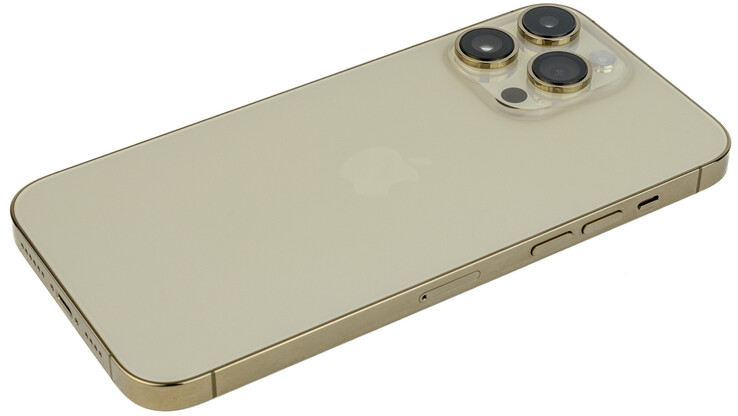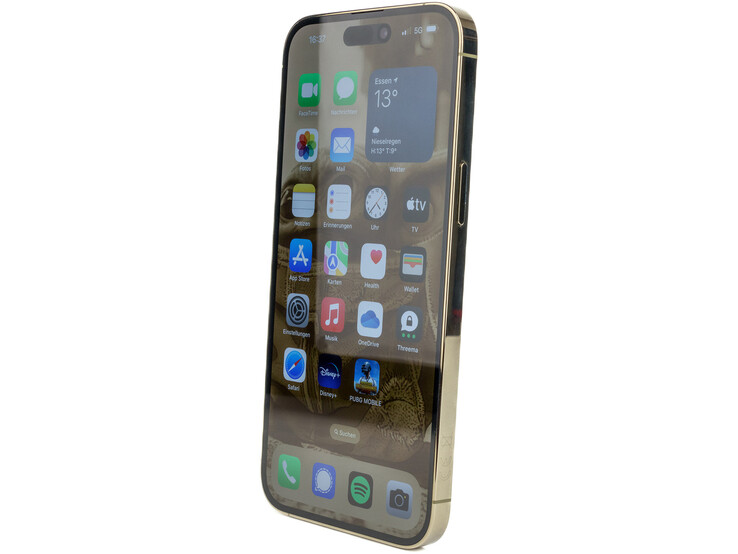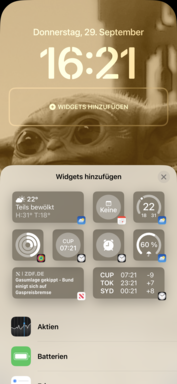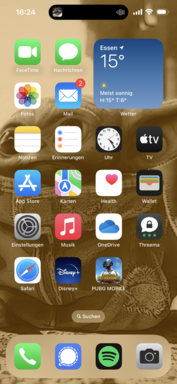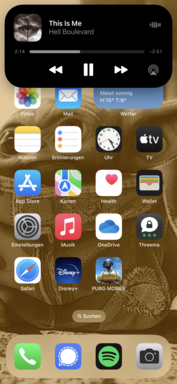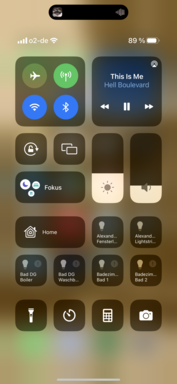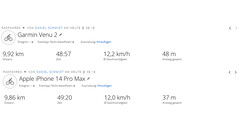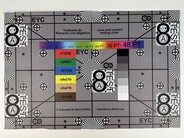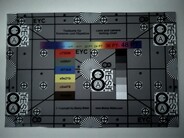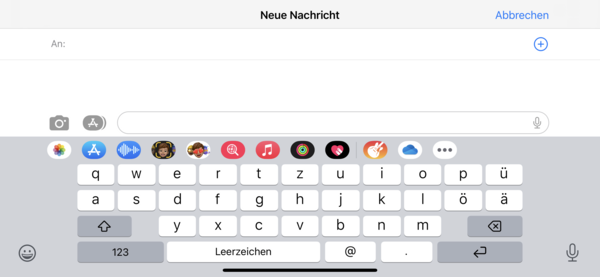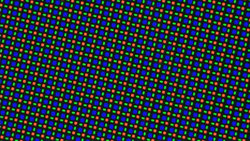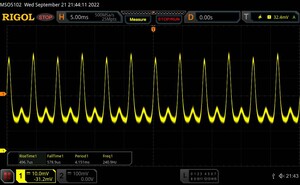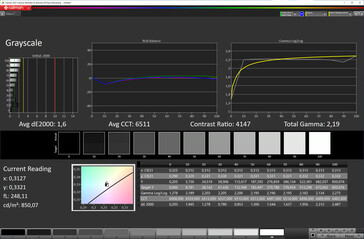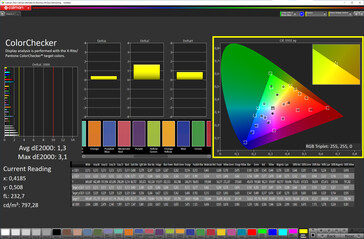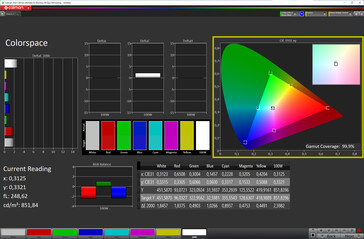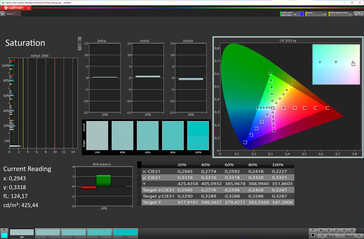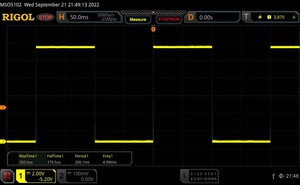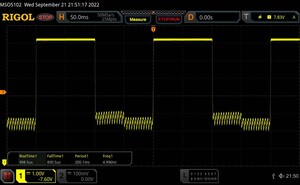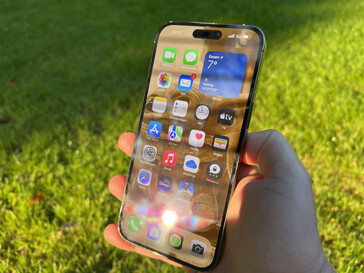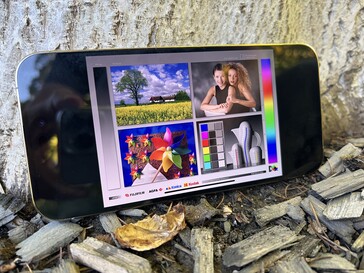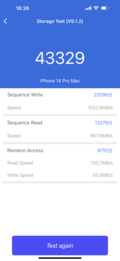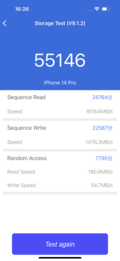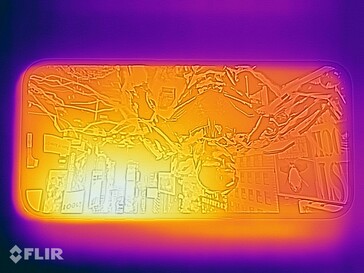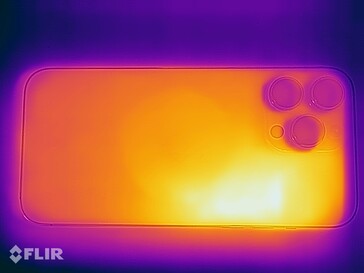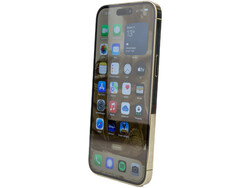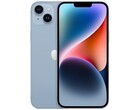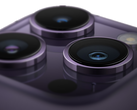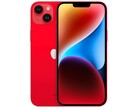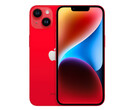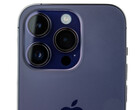Apple iPhone 14 Pro Max review: A gigantic, brawny smartphone
Apple's biggest smartphone has now joined the fray, bringing no changes to the concept of last year's tried and tested iPhone 13 Pro Max. Compared to the smaller iPhone 14 Pro, the larger display is the main focus of attention. Unlike in previous years, however, the cameras are now identical and no small benefit has been implemented in the Max.
Apple has also increased the prices considerably for the large model, which now starts at EUR 1,449 (US$ 1099) in the smallest storage configuration (128 GB) and can cost up to EUR 2,099 (US$ 1599) for 1 TB. US$ 100 more for a larger display seems steep to us. Find out what the iPhone 14 Pro Max has to offer in the following review.
Possible Competitors in Comparison
Rating | Date | Model | Weight | Drive | Size | Resolution | Price |
|---|---|---|---|---|---|---|---|
| 90.3 % v7 (old) | 03 / 2023 | Apple iPhone 14 Pro Max A16, A16 GPU 5-Core | 240 g | 128 GB NVMe | 6.70" | 2796x1290 | |
| 89.4 % v7 (old) | 03 / 2022 | Samsung Galaxy S22 Ultra 5G Exynos 2200, Xclipse 920 | 228 g | 128 GB UFS 3.1 Flash | 6.80" | 3088x1440 | |
| 89.3 % v7 (old) | 10 / 2022 | Motorola Edge 30 Ultra SD 8+ Gen 1, Adreno 730 | 198.5 g | 256 GB UFS 3.1 Flash | 6.67" | 2400x1080 | |
| 88.5 % v7 (old) | 09 / 2022 | Vivo X80 Pro SD 8 Gen 1, Adreno 730 | 215 g | 256 GB UFS 3.1 Flash | 6.78" | 3200x1440 | |
| 88.6 % v7 (old) | 07 / 2022 | Honor Magic4 Pro SD 8 Gen 1, Adreno 730 | 215 g | 256 GB UFS 3.1 Flash | 6.81" | 2848x1312 | |
| 89.2 % v7 (old) | 04 / 2022 | Google Pixel 6 Pro Tensor, Mali-G78 MP20 | 210 g | 128 GB UFS 3.1 Flash | 6.70" | 3120x1440 |
Case - Adé Notch! Welcome Dynamic Island!
The Apple iPhone 14 Pro Max looks huge, even when another smartphone with a similarly sized display is placed alongside it. This impression is further reinforced by the heavy weight of 240 grams and Apple was even brave enough to add another two grams to the scales. Nevertheless, the smartphone feels good in the hands because it is not too top-heavy despite its high weight.
The workmanship is excellent. Gaps are even and very tight, and the haptics are also great. The front and back are protected by durable glass, and the frame is made of highly polished stainless steel. The glass on the front is extremely susceptible to fingerprints, while those on the matte back of our gold model are barely visible. Torsional rigidity is good, but there was some audible creaking inside the iPhone during attempts to twist it.
For the first time since the iPhone X, Apple has dispensed with the notch and replaced it with a dual-punch-hole solution, which was dubbed Dynamic Island. This is an animated software extension that encloses the notches in the display and uses it as an information and input surface. The Apple smartphone is IP68 certified, namely dust- and waterproof, and the battery is permanently installed. The iPhone 14 Pro Max is available in dark purple, gold, silver and space black.
Our colleagues over at iFixit have already disassembled the Pro Max and given it a decent score (6/10), which, however, is worse than the small model since it does not yet take advantage of the improved internal design. Apple provides a sustainability report on its website.
Equipment - iPhone 14 Pro Max continues to use Lightning
The storage configurations of the iPhone 14 Pro Max are identical to last year's model. You can choose from:
- 128 GB for US$ 1099
- 256 GB for US$ 1199
- 512 GB for US$ 1399
- 1 TB for US$ 1599
This means that the Max models have also become noticeably more expensive. The well-known Lightning connector is again available as a physical interface, which does not support high transfer rates, but does support a wide portfolio of optional adapters. Bluetooth 5.3, MagSafe and NFC are also on board.
Software - Dynamic Island at the heart of iOS 16
The Apple iPhone 14 Pro Max comes with Apple's iOS 16, which has implemented the Dynamic Island and Always-On Display (AOD) features for the first time. The former is a software solution to hide the punch holes and to display the information of running apps in a compact, optical way. We really like this in everyday use and find it especially practical. The function has been mostly limited to Apple's own apps so far, but the interface is also open to other app developers. The iPhone also gets an AOD that can be customized. Nothing groundbreaking, but it is quite useful and very well implemented.
You can read about all the new features of iOS 16 here. In the screenshots, the punch holes are hidden if Dynamic Island is not active.
Communication & GNSS - Good positioning, but still no Wi-Fi 6E
Apple's iPhone 14 Pro Max features modern mobile standards and broad frequency coverage, so connections should be possible worldwide without any problems. However, the fast 5G mmWave standard is still exclusively reserved for models in the USA, and the same applies to the emergency call function via satellite (at the time of review).
Wi-Fi 6 is available for the WLAN. The iPhone does not support the newer 6E standard, which means that it cannot use the 6 GHz network. Instead, it has to make do with the slower and more frequented 2.4 and 5.0 GHz bands. In tandem with our Asus ROG Rapture GT-AXE11000 reference router, we registered very stable data transfers, but they fall somewhat short of expectations in terms of speed, especially during receiving.
| Networking | |
| Apple iPhone 14 Pro Max | |
| iperf3 receive AXE11000 | |
| iperf3 transmit AXE11000 | |
| Samsung Galaxy S22 Ultra 5G | |
| iperf3 receive AXE11000 | |
| iperf3 transmit AXE11000 | |
| iperf3 transmit AXE11000 6GHz | |
| iperf3 receive AXE11000 6GHz | |
| Motorola Edge 30 Ultra | |
| iperf3 receive AXE11000 | |
| iperf3 transmit AXE11000 | |
| iperf3 transmit AXE11000 6GHz | |
| iperf3 receive AXE11000 6GHz | |
| Vivo X80 Pro | |
| iperf3 receive AXE11000 | |
| iperf3 transmit AXE11000 | |
| Honor Magic4 Pro | |
| iperf3 receive AXE11000 | |
| iperf3 transmit AXE11000 | |
| Google Pixel 6 Pro | |
| iperf3 receive AXE11000 | |
| iperf3 transmit AXE11000 | |
| Apple iPhone 13 Pro Max | |
| iperf3 transmit AX12 | |
| iperf3 receive AX12 | |
| Average of class Smartphone | |
| iperf3 receive AXE11000 | |
| iperf3 transmit AXE11000 | |
| iperf3 transmit AXE11000 6GHz | |
| iperf3 receive AXE11000 6GHz | |
The iPhone 14 Pro Max uses all global satellite navigation systems, including the dual-band function for localization. Positioning is therefore very fast and precise, even indoors.
On a short bike tour, we compared the Apple smartphone with the Garmin Venu 2. Deviations are minimal both in the details and the total length of the route, but the smartwatch is a little more precise despite the iPhone's solid performance.
Telephony & Voice Quality
When held to the ear, the Apple iPhone 13 Pro Max has a very natural voice quality with decent noise suppression, but reaches its limits in loud background noise and occasionally lets intrusive sounds slip in every now and then.
The speaker can be used well in quiet environments. It does not reverberate but makes the user's voice a little quieter. Nevertheless, the microphone's range is good, even though minor interference can be noticed from time to time, especially in close range. Important features such as VoLTE and Wi-Fi calls are supported. A nano-SIM can be used in our review sample. An eSIM is also available as an alternative.
Cameras - Powerful triple camera in the iPhone 14 Pro Max
The front camera of Apple's iPhone 14 Pro Max has been upgraded after several years and now uses on autofocus and is nominally more light-sensitive with an aperture of f/1.9. With it, you can take good selfies even in dim light.
The triple camera on the back is identical to that of the iPhone 14 Pro, which we discuss in further detail in the corresponding review. The new 48 MP sensor offers a high level of detail and balanced image composition. Furthermore, optical image stabilization with second-generation sensor shift stabilization ensures a steadier hand. Some users report errors in HDR situations, but we have not experienced this issue so far.
The 2x zoom is carried out digitally on the main sensor, but it does its job very well. Optically, threefold magnification is available, which can make use of conventional OIS. The ultra-wide angle again serves as a macro lens. The color deviations from the main lens are not as large as in the predecessor, but still visible.
In terms of videography, Apple has fine-tuned and expanded the Cinema mode, which can now finally record in Ultra HD at 30 FPS. ProRes is also again available, but can only be used to a limited extent at 1,080p and 30 FPS (29 MB/s) on our 128 GB review model. Full 4k/30 FPS (100 MB/s) or Full HD at 60 FPS (59 MB/s) are available on our small 256 GB Pro. Due to the amount of data, however, this decision is quite understandable.
Image comparison
Choose a scene and navigate within the first image. One click changes the position on touchscreens. One click on the zoomed-in image opens the original in a new window. The first image shows the scaled photograph of the test device.
Main cameraMain cameraUltra wide angle5x zoomLow lightThe camera of Apple's iPhone 14 Pro Max also performs well enough under controlled lighting conditions. However, the results in ColorChecker are not so impeccable, showing quite high deviations from the target in the green tones. The image of our test chart is very balanced and even fine details are still visible in the center of the image.
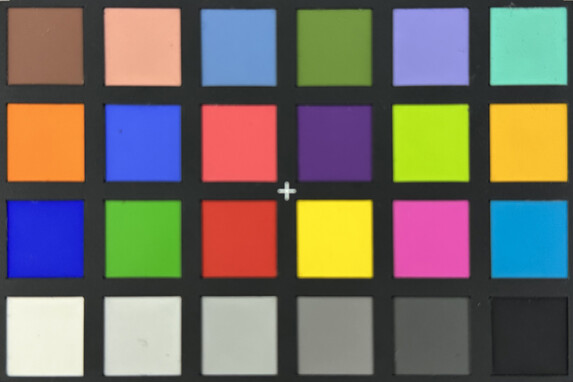
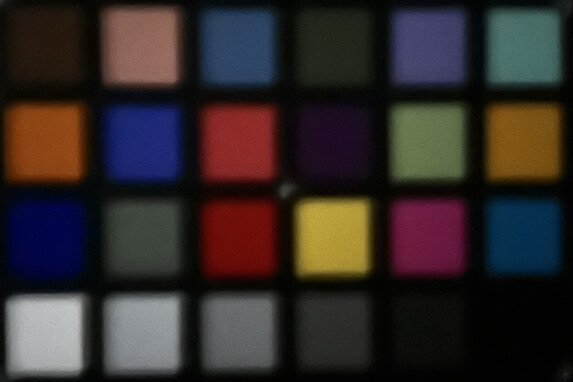
Accessories & Warranty - Care+ becomes more expensive
The scope of delivery of the Apple iPhone 14 Pro Max remains spartan as usual, including only a USB-C to Lightning cable, a SIM tool, a sticker, quick start guide and warranty information. Apple, on the other hand, offers plenty of accessories, of which a matching power adapter is certainly one of the most important, but also extends to cases, MagSafe accessories and much more.
The tight warranty of 12 months can be extended with the Care+ insurance package, which can be purchased directly for two years with a one-time payment or paid monthly. The latter variant is slightly more expensive, but can also run for longer than two years. Overall, the package is now more expensive, but the unintentional damage claims per year are now no longer limited.
Input Devices & Operation - Maximum space
The large capacitive touchscreen of the Apple iPhone 14 Pro Max offers much more space than the small Pro model, which provides a better overview. Gliding properties are excellent and inputs are implemented quickly and precisely.
Apple's keyboard layout now also supports voice input as a parallel input method. Those who prefer to use a different keyboard can get one from the App Store. Face ID is once again exclusively responsible for biometric security. This is a three-dimensional facial recognition, which is not only considered to be very secure, but also works quickly and reliably.
The one-hand mode is already activated ex-factory and can be carried out with a simple swipe over the lower display edge. The tapping gestures for the back are also again present and still distinguishes between double and triple taps, which can trigger different actions and have to be configured in the settings beforehand.
Display - iPhone with super bright 120Hz LTPO OLED
The 6.7-inch Super Retina XDR OLED display of the iPhone 14 Pro Max works at a resolution of 2796 x 1290 and a dynamic refresh rate of 1 to 120 Hz. The brightness is on par with the predecessor regarding a pure white display with an activated ambient light sensor, shining at an average of 1,057 cd/m². Even up to 2,361 cd/m² is achieved in an even distribution of bright and dark areas (APL18), which is even more than specified by Apple(2,000 cd/m²). Those who prefer to adjust the brightness manually have up to 855 cd/m² at their disposal.
The iPhone's ProMotion display also shows the flickering that is typical of OLEDs, but a quite smooth curve with a stable 240 Hz at minimum display brightness. If this is raised above 39 percent, the frequency then rises to a constant 480 Hz, which is comparable to high-frequency DC dimming. The burden for sensitive people should thus be lower. No temporal dithering was determined, which we checked for by examining the display with a microscope and a 240 FPS slow motion video (dark gray, at full brightness).
| |||||||||||||||||||||||||
Brightness Distribution: 99 %
Center on Battery: 1061 cd/m²
Contrast: ∞:1 (Black: 0 cd/m²)
ΔE ColorChecker Calman: 1.3 | ∀{0.5-29.43 Ø4.78}
ΔE Greyscale Calman: 1.6 | ∀{0.09-98 Ø5}
99.9% sRGB (Calman 2D)
Gamma: 2.19
CCT: 6511 K
| Apple iPhone 14 Pro Max Super Retina XDR OLED, 2796x1290, 6.7" | Samsung Galaxy S22 Ultra 5G Dynamic AMOLED, 3088x1440, 6.8" | Motorola Edge 30 Ultra pOLED, 2400x1080, 6.7" | Vivo X80 Pro AMOLED, 3200x1440, 6.8" | Honor Magic4 Pro OLED, 2848x1312, 6.8" | Google Pixel 6 Pro LTPO-OLED, 3120x1440, 6.7" | Apple iPhone 13 Pro Max OLED, 2778x1284, 6.7" | |
|---|---|---|---|---|---|---|---|
| Screen | 11% | -2% | 11% | -47% | 3% | 22% | |
| Brightness middle (cd/m²) | 1061 | 1077 2% | 1020 -4% | 938 -12% | 956 -10% | 794 -25% | 1049 -1% |
| Brightness (cd/m²) | 1057 | 1093 3% | 1020 -4% | 947 -10% | 959 -9% | 801 -24% | 1060 0% |
| Brightness Distribution (%) | 99 | 97 -2% | 96 -3% | 97 -2% | 94 -5% | 97 -2% | 98 -1% |
| Black Level * (cd/m²) | |||||||
| Colorchecker dE 2000 * | 1.3 | 1.2 8% | 1 23% | 0.9 31% | 2.4 -85% | 0.9 31% | 0.78 40% |
| Colorchecker dE 2000 max. * | 3.1 | 2 35% | 2.8 10% | 1.9 39% | 5.2 -68% | 2.2 29% | 1.72 45% |
| Greyscale dE 2000 * | 1.6 | 1.3 19% | 2.1 -31% | 1.3 19% | 3.3 -106% | 1.5 6% | 0.8 50% |
| Gamma | 2.19 100% | 2.37 93% | 2.29 96% | 2.2 100% | 2.26 97% | 2.23 99% | 2.181 101% |
| CCT | 6511 100% | 6526 100% | 6502 100% | 6518 100% | 6804 96% | 6654 98% | 6559 99% |
* ... smaller is better
Screen Flickering / PWM (Pulse-Width Modulation)
| Screen flickering / PWM detected | 240.9 Hz | ||
The display backlight flickers at 240.9 Hz (worst case, e.g., utilizing PWM) . The frequency of 240.9 Hz is relatively low, so sensitive users will likely notice flickering and experience eyestrain at the stated brightness setting and below. In comparison: 53 % of all tested devices do not use PWM to dim the display. If PWM was detected, an average of 8118 (minimum: 5 - maximum: 343500) Hz was measured. | |||
Series of measurement at a fixed zoom level and different brightness settings
Regarding color representation accuracy, Apple doesn't mess around: this shows a high degree of accuracy with a good white balance. This is only achieved if the True Tone mode is omitted. Otherwise the display is still very accurate, but a little warmer.
Display Response Times
| ↔ Response Time Black to White | ||
|---|---|---|
| 0.73 ms ... rise ↗ and fall ↘ combined | ↗ 0.3505 ms rise | |
| ↘ 0.3795 ms fall | ||
| The screen shows very fast response rates in our tests and should be very well suited for fast-paced gaming. In comparison, all tested devices range from 0.1 (minimum) to 240 (maximum) ms. » 2 % of all devices are better. This means that the measured response time is better than the average of all tested devices (20.2 ms). | ||
| ↔ Response Time 50% Grey to 80% Grey | ||
| 1.89 ms ... rise ↗ and fall ↘ combined | ↗ 0.9985 ms rise | |
| ↘ 0.8905 ms fall | ||
| The screen shows very fast response rates in our tests and should be very well suited for fast-paced gaming. In comparison, all tested devices range from 0.165 (minimum) to 636 (maximum) ms. » 8 % of all devices are better. This means that the measured response time is better than the average of all tested devices (31.6 ms). | ||
Performance - Apple's A16 Bionic provides a lot of power
The Apple iPhone 14 Pro Max is powered by Apple A16 Bionic, which is able draw on 6 GB of LPDDR5 working memory. In terms of CPU performance, the SoC easily outperforms the assembled Android competition.
The lead is not always as clear in the system benchmarks. The iPhone produces a clear performance advantage with 20% more points in Crossmark, but falls behind the Edge 30 Ultra in AnTuTu.
The storage speed is on a similar level as the predecessor, but it is noticeable that the 128 GB variant is slower than the larger models, which is probably due to the fact that only one storage module is used in the smallest model.
| Geekbench ML | |
| 0.5 TensorFlow Lite GPU | |
| Apple iPhone 14 Pro Max | |
| Average Apple A16 Bionic (2207 - 2540, n=3) | |
| Motorola Edge 30 Ultra | |
| Vivo X80 Pro | |
| Honor Magic4 Pro | |
| Samsung Galaxy S22 Ultra 5G | |
| 0.5 TensorFlow Lite CPU 0.5 | |
| Average Apple A16 Bionic (1016 - 1135, n=3) | |
| Apple iPhone 14 Pro Max | |
| Motorola Edge 30 Ultra | |
| Vivo X80 Pro | |
| Honor Magic4 Pro | |
| Samsung Galaxy S22 Ultra 5G | |
| 0.5 TensorFlow Lite NNAPI / Core ML | |
| Average Apple A16 Bionic (3170 - 3377, n=4) | |
| Apple iPhone 14 Pro Max | |
| Honor Magic4 Pro | |
| Vivo X80 Pro | |
| Motorola Edge 30 Ultra | |
| Samsung Galaxy S22 Ultra 5G | |
The A16-GPU is said to achieve 19% higher performance compared to its predecessor, which is only partially confirmed in the benchmarks. Nevertheless, it is the fastest GPU in a smartphone and the Adreno 730 only rarely manages to catch up with it, but stays quite close in modern tests.
A completely different picture emerges in the onscreen tests and the iPhone often lags behind the competition. However, this is because the frame rates in the Apple smartphone's tests are capped at 60 FPS, while the Android smartphones can usually max out their full refresh rates.
GFXBench (DX / GLBenchmark) 2.7: T-Rex Onscreen | 1920x1080 T-Rex Offscreen
GFXBench 3.0: on screen Manhattan Onscreen OGL | 1920x1080 1080p Manhattan Offscreen
GFXBench 3.1: on screen Manhattan ES 3.1 Onscreen | 1920x1080 Manhattan ES 3.1 Offscreen
GFXBench: on screen Car Chase Onscreen | 1920x1080 Car Chase Offscreen | on screen Aztec Ruins High Tier Onscreen | 2560x1440 Aztec Ruins High Tier Offscreen | on screen Aztec Ruins Normal Tier Onscreen | 1920x1080 Aztec Ruins Normal Tier Offscreen | 3840x2160 4K Aztec Ruins High Tier Offscreen
| 3DMark / Wild Life Extreme Unlimited | |
| Apple iPhone 14 Pro Max | |
| Apple iPhone 13 Pro Max | |
| Motorola Edge 30 Ultra | |
| Honor Magic4 Pro | |
| Vivo X80 Pro | |
| Google Pixel 6 Pro | |
| Samsung Galaxy S22 Ultra 5G | |
| 3DMark / Wild Life Extreme | |
| Apple iPhone 14 Pro Max | |
| Apple iPhone 13 Pro Max | |
| Motorola Edge 30 Ultra | |
| Honor Magic4 Pro | |
| Vivo X80 Pro | |
| Samsung Galaxy S22 Ultra 5G | |
| Google Pixel 6 Pro | |
| 3DMark / Wild Life Unlimited Score | |
| Apple iPhone 14 Pro Max | |
| Apple iPhone 13 Pro Max | |
| Motorola Edge 30 Ultra | |
| Honor Magic4 Pro | |
| Vivo X80 Pro | |
| Samsung Galaxy S22 Ultra 5G | |
| Google Pixel 6 Pro | |
| GFXBench (DX / GLBenchmark) 2.7 / T-Rex Onscreen | |
| Motorola Edge 30 Ultra | |
| Honor Magic4 Pro | |
| Samsung Galaxy S22 Ultra 5G | |
| Google Pixel 6 Pro | |
| Apple iPhone 13 Pro Max | |
| Vivo X80 Pro | |
| Apple iPhone 14 Pro Max | |
| GFXBench (DX / GLBenchmark) 2.7 / T-Rex Offscreen | |
| Motorola Edge 30 Ultra | |
| Apple iPhone 14 Pro Max | |
| Honor Magic4 Pro | |
| Apple iPhone 13 Pro Max | |
| Samsung Galaxy S22 Ultra 5G | |
| Vivo X80 Pro | |
| Google Pixel 6 Pro | |
| GFXBench 3.0 / Manhattan Onscreen OGL | |
| Motorola Edge 30 Ultra | |
| Honor Magic4 Pro | |
| Samsung Galaxy S22 Ultra 5G | |
| Google Pixel 6 Pro | |
| Apple iPhone 13 Pro Max | |
| Vivo X80 Pro | |
| Apple iPhone 14 Pro Max | |
| GFXBench 3.0 / 1080p Manhattan Offscreen | |
| Apple iPhone 14 Pro Max | |
| Motorola Edge 30 Ultra | |
| Apple iPhone 13 Pro Max | |
| Samsung Galaxy S22 Ultra 5G | |
| Honor Magic4 Pro | |
| Vivo X80 Pro | |
| Google Pixel 6 Pro | |
| GFXBench 3.1 / Manhattan ES 3.1 Onscreen | |
| Motorola Edge 30 Ultra | |
| Honor Magic4 Pro | |
| Samsung Galaxy S22 Ultra 5G | |
| Apple iPhone 13 Pro Max | |
| Vivo X80 Pro | |
| Apple iPhone 14 Pro Max | |
| Google Pixel 6 Pro | |
| GFXBench 3.1 / Manhattan ES 3.1 Offscreen | |
| Apple iPhone 14 Pro Max | |
| Motorola Edge 30 Ultra | |
| Honor Magic4 Pro | |
| Apple iPhone 13 Pro Max | |
| Samsung Galaxy S22 Ultra 5G | |
| Vivo X80 Pro | |
| Google Pixel 6 Pro | |
| GFXBench / Car Chase Onscreen | |
| Motorola Edge 30 Ultra | |
| Apple iPhone 14 Pro Max | |
| Honor Magic4 Pro | |
| Apple iPhone 13 Pro Max | |
| Vivo X80 Pro | |
| Samsung Galaxy S22 Ultra 5G | |
| Google Pixel 6 Pro | |
| GFXBench / Car Chase Offscreen | |
| Motorola Edge 30 Ultra | |
| Apple iPhone 14 Pro Max | |
| Honor Magic4 Pro | |
| Apple iPhone 13 Pro Max | |
| Samsung Galaxy S22 Ultra 5G | |
| Vivo X80 Pro | |
| Google Pixel 6 Pro | |
| GFXBench / Aztec Ruins High Tier Onscreen | |
| Motorola Edge 30 Ultra | |
| Apple iPhone 13 Pro Max | |
| Apple iPhone 14 Pro Max | |
| Vivo X80 Pro | |
| Honor Magic4 Pro | |
| Google Pixel 6 Pro | |
| Samsung Galaxy S22 Ultra 5G | |
| GFXBench / Aztec Ruins High Tier Offscreen | |
| Motorola Edge 30 Ultra | |
| Honor Magic4 Pro | |
| Apple iPhone 14 Pro Max | |
| Apple iPhone 13 Pro Max | |
| Vivo X80 Pro | |
| Google Pixel 6 Pro | |
| Samsung Galaxy S22 Ultra 5G | |
| GFXBench / Aztec Ruins Normal Tier Onscreen | |
| Motorola Edge 30 Ultra | |
| Honor Magic4 Pro | |
| Vivo X80 Pro | |
| Apple iPhone 14 Pro Max | |
| Apple iPhone 13 Pro Max | |
| Google Pixel 6 Pro | |
| Samsung Galaxy S22 Ultra 5G | |
| GFXBench / Aztec Ruins Normal Tier Offscreen | |
| Apple iPhone 14 Pro Max | |
| Motorola Edge 30 Ultra | |
| Honor Magic4 Pro | |
| Apple iPhone 13 Pro Max | |
| Vivo X80 Pro | |
| Google Pixel 6 Pro | |
| Samsung Galaxy S22 Ultra 5G | |
| GFXBench / 4K Aztec Ruins High Tier Offscreen | |
| Motorola Edge 30 Ultra | |
| Apple iPhone 14 Pro Max | |
| Honor Magic4 Pro | |
| Vivo X80 Pro | |
Basemark GPUScore
The iPhone 14 Pro Max is in a class of its own in the browser benchmarks and leaves its rivals in the dust. Subjectively, however, the difference is not that large.
| Jetstream 2 - 2.0 Total Score | |
| Apple iPhone 14 Pro Max (Safari 16) | |
| Average Apple A16 Bionic (228 - 282, n=5) | |
| Apple iPhone 13 Pro Max (Safari 15) | |
| Average of class Smartphone (23.8 - 387, n=153, last 2 years) | |
| Motorola Edge 30 Ultra (Chrome 105) | |
| Samsung Galaxy S22 Ultra 5G (Chrome 99) | |
| Google Pixel 6 Pro (Chrome 100) | |
| Honor Magic4 Pro (Chrome 102) | |
| Vivo X80 Pro | |
| Speedometer 2.0 - Result 2.0 | |
| Average Apple A16 Bionic (327 - 419, n=4) | |
| Apple iPhone 14 Pro Max (Safari 16) | |
| Apple iPhone 13 Pro Max (Safari 15) | |
| Average of class Smartphone (15.2 - 643, n=128, last 2 years) | |
| Google Pixel 6 Pro (Chrome 100) | |
| Samsung Galaxy S22 Ultra 5G (Chrome 99) | |
| Motorola Edge 30 Ultra (Chrome 105) | |
| Vivo X80 Pro (Chrome 103) | |
| Honor Magic4 Pro (Chrome 102) | |
| WebXPRT 4 - Overall | |
| Average Apple A16 Bionic (201 - 236, n=3) | |
| Apple iPhone 14 Pro Max (Safari 16) | |
| Average of class Smartphone (27 - 306, n=147, last 2 years) | |
| Motorola Edge 30 Ultra (Chrome 105) | |
| Honor Magic4 Pro (Chrome 102) | |
| WebXPRT 3 - Overall | |
| Apple iPhone 14 Pro Max (Safari 16) | |
| Average Apple A16 Bionic (286 - 292, n=4) | |
| Apple iPhone 13 Pro Max (Safari 15) | |
| Average of class Smartphone (38 - 380, n=35, last 2 years) | |
| Motorola Edge 30 Ultra (Chrome 105) | |
| Samsung Galaxy S22 Ultra 5G (Chrome 99) | |
| Google Pixel 6 Pro (Chrome 100) | |
| Honor Magic4 Pro (Chrome 102) | |
| Vivo X80 Pro (Chrome 103) | |
| Octane V2 - Total Score | |
| Average Apple A16 Bionic (68554 - 75718, n=5) | |
| Apple iPhone 14 Pro Max (Safari 16) | |
| Apple iPhone 13 Pro Max (Safari 15) | |
| Average of class Smartphone (2228 - 121337, n=200, last 2 years) | |
| Vivo X80 Pro (Chrome 103) | |
| Google Pixel 6 Pro (Chrome 100) | |
| Motorola Edge 30 Ultra (Chrome 105) | |
| Samsung Galaxy S22 Ultra 5G (Chrome 99) | |
| Honor Magic4 Pro (Chrome 102) | |
| Mozilla Kraken 1.1 - Total | |
| Honor Magic4 Pro (Chrome 102) | |
| Samsung Galaxy S22 Ultra 5G (Chrome 99) | |
| Vivo X80 Pro (Chrome 103) | |
| Average of class Smartphone (257 - 28190, n=155, last 2 years) | |
| Motorola Edge 30 Ultra (Chrome 105) | |
| Google Pixel 6 Pro (Chrome 100) | |
| Apple iPhone 14 Pro Max (Safari 16) | |
| Average Apple A16 Bionic (411 - 506, n=5) | |
| Apple iPhone 13 Pro Max (Safari 15) | |
* ... smaller is better
Gaming - Bigger display = more fun
The A16-GPU offers more than enough power for all games in the App Store and future games in the coming years. The large display is real added value compared to the iPhone 14 Pro when gaming, as the additional display area should not be underestimated.
Unfortunately, we are unable to present any gaming benchmarks at this point, since our partner GameBench does not yet support the new iOS version. However, we will do this as soon as possible in the next few days.
Emissions - The iPhone 14 Pro Max gets warmer than the small Pro
Temperature
The iPhone 14 Pro Max is a few degrees warmer on the surface than the iPhone 14 Pro when idling. It gets hot under prolonged load and can reach up to 44 °C, which is no longer in the category of pleasant, but is still harmless.
The iPhone 14 Pro Max's nominally more stable performance than the smaller 14 Pro is due to the fact that it starts the 3DMark Wild Life stress test at a lower base frame rate. In fact, it is even a little slower at the end of the 20 runs and only achieves three frames more than its predecessor.
(±) The maximum temperature on the upper side is 41.4 °C / 107 F, compared to the average of 35.2 °C / 95 F, ranging from 21.9 to 247 °C for the class Smartphone.
(±) The bottom heats up to a maximum of 44 °C / 111 F, compared to the average of 34 °C / 93 F
(+) In idle usage, the average temperature for the upper side is 30.7 °C / 87 F, compared to the device average of 32.9 °C / 91 F.
3DMark Wild Life Stress Test
| 3DMark | |
| Wild Life Stress Test Stability | |
| Apple iPhone 14 Pro Max | |
| Vivo X80 Pro | |
| Honor Magic4 Pro | |
| Motorola Edge 30 Ultra | |
| Samsung Galaxy S22 Ultra 5G | |
| Google Pixel 6 Pro | |
| Wild Life Extreme Stress Test | |
| Vivo X80 Pro | |
| Apple iPhone 14 Pro Max | |
| Motorola Edge 30 Ultra | |
| Honor Magic4 Pro | |
| Samsung Galaxy S22 Ultra 5G | |
| Google Pixel 6 Pro | |
Speakers
The two speakers of the Apple iPhone 14 Pro Max deliver a quite good sound output and have improved compared to the predecessor, especially in terms of the linearity of the high tones, and the low mids have also become somewhat more powerful.
Wired headphones can be connected to the smartphone via the Lightning port. This can also be done wirelessly via Bluetooth, but the iPhone does not support a particularly wide range of audio codecs.
Apple iPhone 14 Pro Max audio analysis
(+) | speakers can play relatively loud (89 dB)
Bass 100 - 315 Hz
(-) | nearly no bass - on average 20.1% lower than median
(±) | linearity of bass is average (7.9% delta to prev. frequency)
Mids 400 - 2000 Hz
(+) | balanced mids - only 4.6% away from median
(+) | mids are linear (4.5% delta to prev. frequency)
Highs 2 - 16 kHz
(±) | higher highs - on average 5.3% higher than median
(+) | highs are linear (1.4% delta to prev. frequency)
Overall 100 - 16.000 Hz
(±) | linearity of overall sound is average (15.4% difference to median)
Compared to same class
» 3% of all tested devices in this class were better, 3% similar, 94% worse
» The best had a delta of 11%, average was 35%, worst was 134%
Compared to all devices tested
» 22% of all tested devices were better, 4% similar, 74% worse
» The best had a delta of 4%, average was 24%, worst was 134%
Google Pixel 6 Pro audio analysis
(+) | speakers can play relatively loud (84.6 dB)
Bass 100 - 315 Hz
(-) | nearly no bass - on average 18.5% lower than median
(±) | linearity of bass is average (12% delta to prev. frequency)
Mids 400 - 2000 Hz
(+) | balanced mids - only 4.4% away from median
(+) | mids are linear (6.5% delta to prev. frequency)
Highs 2 - 16 kHz
(±) | higher highs - on average 6.2% higher than median
(±) | linearity of highs is average (8.6% delta to prev. frequency)
Overall 100 - 16.000 Hz
(±) | linearity of overall sound is average (16.8% difference to median)
Compared to same class
» 8% of all tested devices in this class were better, 7% similar, 85% worse
» The best had a delta of 11%, average was 35%, worst was 134%
Compared to all devices tested
» 28% of all tested devices were better, 7% similar, 64% worse
» The best had a delta of 4%, average was 24%, worst was 134%
Battery Life - Long endurance and slow charging
Power Consumption
The power consumption of the iPhone 14 Pro Max has been improved, which does not apply to the fast charging options. Those using a 20-watt power adapter should be able to charge the battery to 50% within 30 minutes, which is just as fast as the small Pro despite the larger battery. Android smartphones are considerably faster. The Honor Magic4 Pro, for example, fully recharges its battery with 100 watts in 20 minutes.
Alternatively, the Apple smartphone can be charged with 15 watts on a MagSafe charging plate or with 7.5 watts on a Qi-compatible charging surface.
| Off / Standby | |
| Idle | |
| Load |
|
Key:
min: | |
| Apple iPhone 14 Pro Max 4323 mAh | Samsung Galaxy S22 Ultra 5G 5000 mAh | Motorola Edge 30 Ultra 4610 mAh | Vivo X80 Pro 4700 mAh | Honor Magic4 Pro 4600 mAh | Google Pixel 6 Pro 5003 mAh | Apple iPhone 13 Pro Max 4352 mAh | Average Apple A16 Bionic | Average of class Smartphone | |
|---|---|---|---|---|---|---|---|---|---|
| Power Consumption | -16% | 3% | -29% | -30% | -16% | 10% | -51% | -38% | |
| Idle Minimum * (Watt) | 0.61 | 0.58 5% | 0.74 -21% | 0.92 -51% | 0.87 -43% | 0.7 -15% | 0.6 2% | 0.842 ? -38% | 0.848 ? -39% |
| Idle Average * (Watt) | 1.7 | 0.71 58% | 1.84 -8% | 2.04 -20% | 2.04 -20% | 1 41% | 1.5 12% | 2.66 ? -56% | 1.435 ? 16% |
| Idle Maximum * (Watt) | 1.73 | 1.16 33% | 1.86 -8% | 2.05 -18% | 2.26 -31% | 1.04 40% | 1.6 8% | 2.71 ? -57% | 1.621 ? 6% |
| Load Average * (Watt) | 3.85 | 7.07 -84% | 2.75 29% | 4.29 -11% | 4.97 -29% | 6.87 -78% | 3.5 9% | 5.76 ? -50% | 6.99 ? -82% |
| Load Maximum * (Watt) | 5.94 | 11.32 -91% | 4.54 24% | 8.75 -47% | 7.46 -26% | 9.87 -66% | 4.8 19% | 9.28 ? -56% | 11.3 ? -90% |
* ... smaller is better
Power Consumption: Geekbench (150 cd/m²)
Power Consumption: GFXBench (150 cd/m²)
Battery Life
Battery runtimes are significantly longer than in the small Pro model, and the entire comparison field cannot keep up in this regard either. But the runtimes aren't necessarily better than those of the 13 Pro Max. In particular, the realistic WLAN test with a fixed display brightness (150 cd/m²) is weaker, whereby result of just under 16 hours is still a very good result.
| Apple iPhone 14 Pro Max 4323 mAh | Samsung Galaxy S22 Ultra 5G 5000 mAh | Motorola Edge 30 Ultra 4610 mAh | Vivo X80 Pro 4700 mAh | Honor Magic4 Pro 4600 mAh | Google Pixel 6 Pro 5003 mAh | Apple iPhone 13 Pro Max 4352 mAh | |
|---|---|---|---|---|---|---|---|
| Battery runtime | -23% | -24% | -35% | -34% | -30% | -2% | |
| Reader / Idle (h) | 57.9 | 32.9 -43% | 36.8 -36% | 28.8 -50% | 22.4 -61% | 47.4 -18% | |
| H.264 (h) | 28.1 | 18 -36% | 19.8 -30% | 15.7 -44% | 16.6 -41% | 25.4 -10% | |
| WiFi v1.3 (h) | 15.8 | 14.1 -11% | 14.5 -8% | 14.2 -10% | 11.5 -27% | 11.1 -30% | 17.8 13% |
| Load (h) | 6.9 | 6.8 -1% | 5.4 -22% | 4.5 -35% | 6.5 -6% | 7.5 9% |
Pros
Cons
Verdict - More runtime and a bigger panel
The Apple iPhone 14 Pro Max is very similar to its little brother, the 14 Pro, just bigger and heavier. The display even turned out to be a little brighter in our tests, but the SoC is a bit slower. Either way, both differences are insignificant and will not play a role in everyday use. The new features are also the same, including Dynamic Island, as well as the new triple camera with a 48 MPix sensor.
The Apple iPhone 14 Pro Max is a big brawny smartphone for those wanting a large display and more battery life.
So if you want the largest possible display, you can go for the Max without hesitation. Apart from the heavier weight, there are no disadvantages. Even the battery runtimes are longer, since the jumbo iPhone offers room for a bigger battery. However, the battery's performance gains are proportional to the longer battery runtimes. If our calculations are correct, these should be around 35% higher, which is not nearly the case. The gains vary between 17 and 31 percent in our tests. The high power loss may partly explain the higher surface temperatures under load. But even if the yield is not optimal, the runtimes are still very good.
Those who prefer a compacter smartphone should take a look at the iPhone 14 Pro. Outside the Apple universe, the Oppo Find X5 Pro, Vivo X80 Pro or the Motorola Edge 30 Ultra are strong alternatives.
Price and Availability
The iPhone 14 Pro Max is available in all color and storage versions directly from Apple. The model is also usually available via Amazon or other popular retailers, depending on your country, and tends to be a little cheaper.
Apple iPhone 14 Pro Max
- 10/01/2022 v7 (old)
Daniel Schmidt




